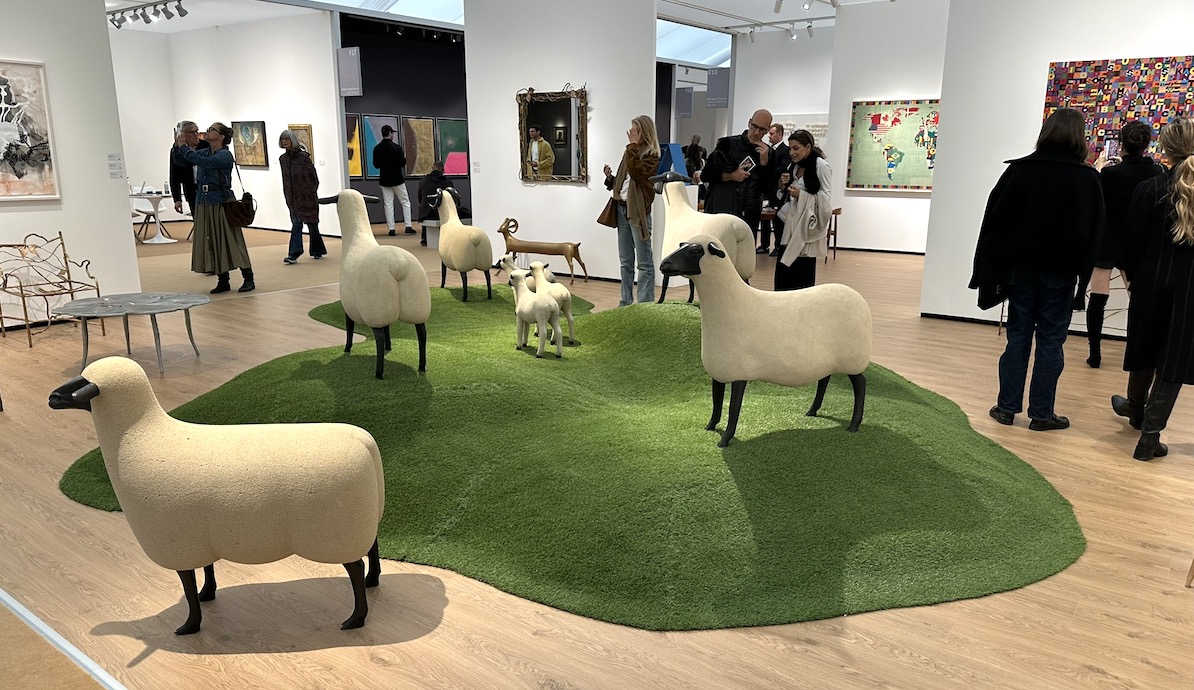Nico Kos Earle gives an artful roundup in London during the Autumn season.
PART 1 – PREAMBLE
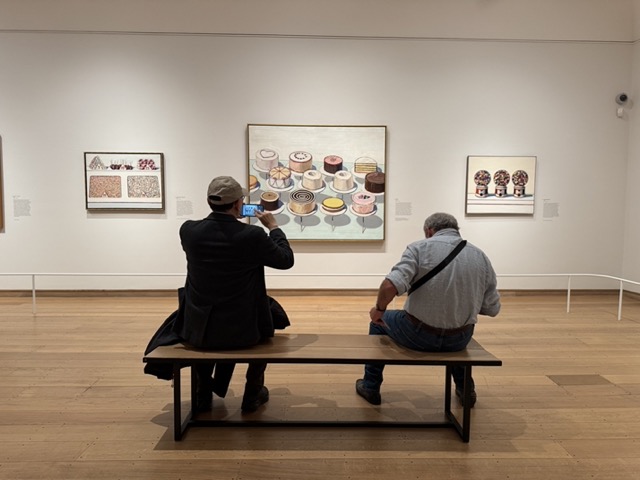
My frieze week started with ‘Cupid and Psyche’ (1789) at the Courtauld, illuminated by the single flame of a candle – that unforgettable image by Joshua Reynolds of love laid utterly bare. Seen on my way into Wayne Thiebaud’s exhibition ‘American Still Life’, its stark contrast to the saccharine brightness of his shadowless cravings seemed to highlight the tragic irony of the National Gallery of Art (Washington, D.C.) closing its doors. A show that satisfies a secret desire just to eat cake—and forget the painful deluge of current events—his unctuous depictions of food waiting to be consumed left me feeling empty and hungry.
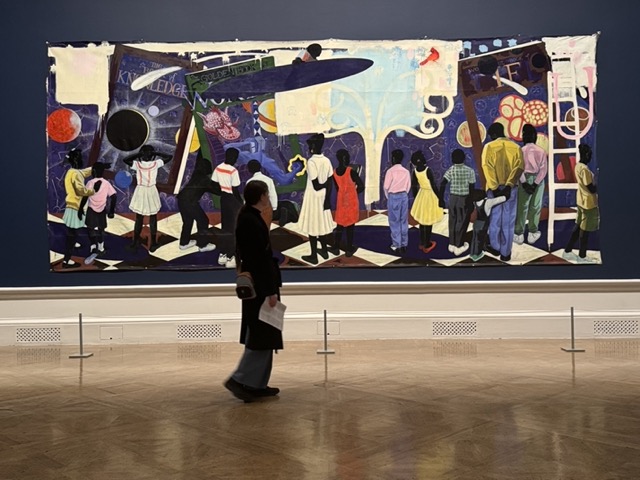
The flesh it demands more; it requires our full, unflinching consideration. Walking on to the Royal Academy of Arts, I walked into ‘The Histories’ by Kerry James Marshal, who does away with shadows altogether and creates phenomenal presence through what is unequivocally black and beautiful. His Invisible Man series – black on black – shows us the madness of a category that does not properly describe the full spectrum, and how empowering it can be to address this imaginatively “What I am interested in more than anything is invention,” says Marshal in the catalogue, “I am not interested in appropriation.”
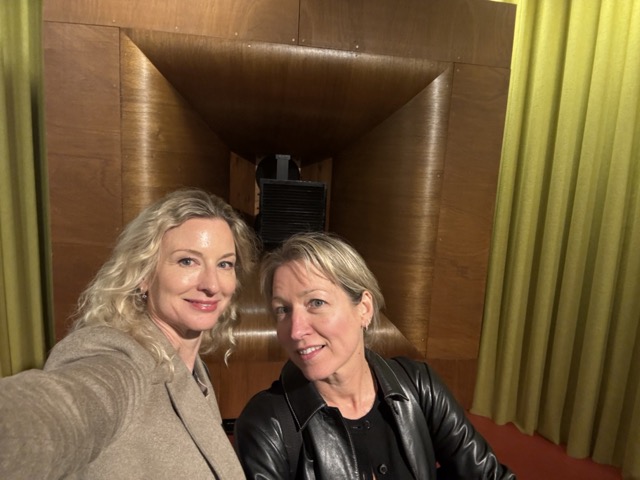
All these magnificent figures would find their echo later in Peter Doig’s ‘House of Music’ at the Serpentine: white and black figures illuminated in the tuneful glow of a full moon gathering. To get beneath the surface of things, Doig often paints through the night whilst listening to music. Doig explained at the opening, “I’ve tried over the years to make paintings that are imagistic and atmospheric in the way music can be.” In this exhibition, he incorporates giant analogue speakers that play music from his personal record archive. Sharing his tunes is a monumentally generous act, giving us access to the soundtrack of his inner life. In the final darkened room, black-and-white bodies dance, pose, and linger with the kind of ease that follows when the lights go out. Illuminated by the light of the moon, these figures are a reminder that colour categories are things we carry in the mind, and as the French say, “dans le noir tous les chats sont gris.”
More than flesh, what both artists show us is that to be human is to be feeling. This circuitous route through some of the many exhibitions opening ahead of Frieze set us up elegantly for an encounter with one to watch, Marcus Leotaud, at the Bomb Factory. Born in Trinidad (where Doig used to live) and moving to London for his MFA at Chelsea College, his recent paintings focus on the twilight hour with figures subtly outlined, emerging or vanishing into the darkness. Exploring the disappearance of light as a metaphor, in an interview with AnOther magazine, he said, “I’m interested in the missing parts… in the gaps and in those moments where we fail to see each other clearly.”
PART 2 – MEMORIES FROM THE TENTS
If Frieze @friezeofficial was named after the technical term for a wall work in carved relief (but also a homophone of the landmark 1988 exhibition Freeze, which consolidated the BritArt movement), it got me thinking. Imagine if there was a place (a mountain – a cave) where every year everything that was shown left an imprint on the walls, which slowly accumulated a visual diary. Impossible to imagine the picture – a blur – so Frieze becomes Freeze again which somehow describes the mental snowdrift we enter once inside the tent trying to grasp but unable to fully retain anything. We try to linger and record the moment, iPhones in hand, with a deep sense of responsibility towards all the artists, gallerists, curators, and workers in this freewheeling market who bring us the greatest fair in town.
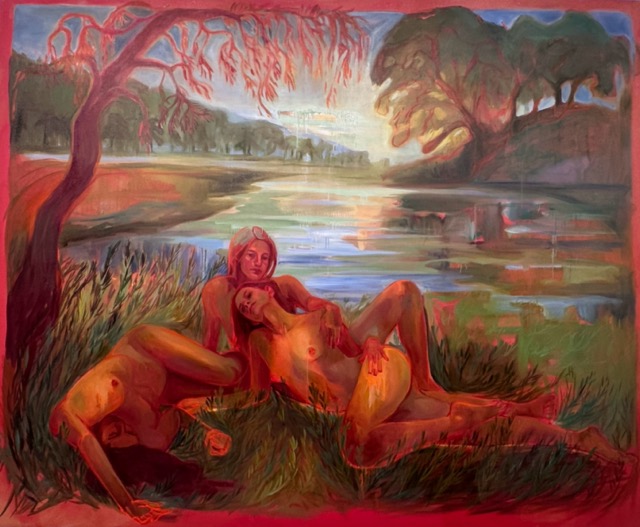
This year, London was endlessly inventive and reassuringly cheeky; a bronze sculpture – big tits over skinny legs with stilettos, sitting cross-legged on a chair – by Sarah Lucas at Sadie Coles seemed emblematic of the mad mood everyone was in. Yes, the art market is in flux, but creative resilience is a hallmark of this industry. This was supremely evident at the Carl Freedman Gallery, where two dancing figures in cobalt blue that might have jumped out of Hermes’ window. Just a reminder: in the visual arts, priming is everything. First, we were drawn to a large abstraction by Lola Stong Brett. Both spacious and expressive, whilst certain gestures faintly echoed Tracy Emin, a boldness of colour and line captured a raw energy. Next to this was a sensational landscape by Vanessa Raw, featuring three naked women reclining and entwined on a riverbank. Breasts and thighs highlighted, burning-hot flesh in vermillion and ochre, against the soft green and blue behind, this work speaks to the anticipatory thirst of female desire. @carlfreedmangallery
At a fair, one cannot take everything in; one can only catch the tail of a visual theme and follow. Tonally, Raw’s paintings sparked a conversation with Jane Bustin’s compact three-dimensional works at the Jane Lombard Gallery, in dulcet tones of plum, pink, maroon, and apricot, featuring elements from the Pirelli Calendar. Her series’ Pirelli, Let Me Count the Ways’ explores the intangible flicker of female erotica through the layered history of men’s gaze @janelombardgallery. This led me to Leiko Ikemura @lissongallery who paints strangely familiar, biomorphic forms in light, delicate washes of pastel colours on a charcoal ground – redolent of stardust. They called to mind the soft, hazy photographic works of Johnny Mae Hauser, both artists on my wish list. Yes, buy them now.
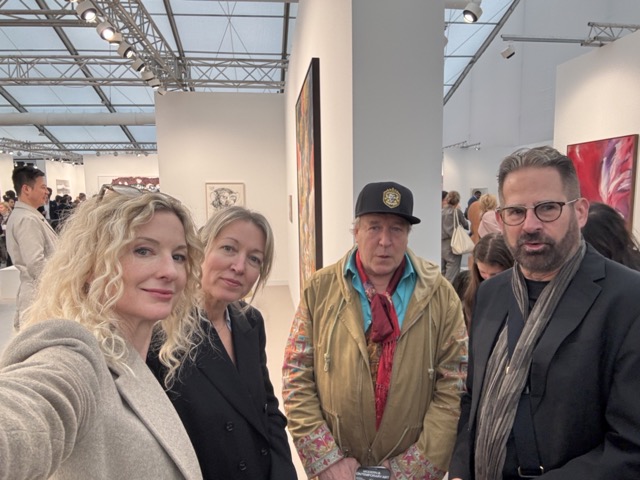
One artist I wish I could have on my walls is Hayley Barker, back at the fair with @ingleby – as everyone is talking about who might possibly represent the USA in May at the Venice Biennale – she would be my last-minute choice, though unlikely capable of working to a short deadline. I was thinking this whilst standing over a brightly painted wooden cart by Lubaina Himid at Hollybush Gardens, who is representing Great Britain next year, an elegant soft power choice… @hollybushgardens That got me thinking – will India have a pavilion this year? Surely some of the patrons at the British Museum’s inaugural Pink Ball extravaganza could club together. I went looking for @naturemorte’s stand and found myself staring into a pastoral darkness depicting two empty canoes resting on the bank of a dry riverbed by Saad Qureshi. A welcome, if sombre palette cleanse, not dissimilar to William Kentridge’s old Rand mine works, scratching at the surface of post-colonialism. From this, I joined my editor, Paul Carter Robinson, for an announcement by V&A East, which has chosen Turner Prize winner Jasleen Kaur for its next sculptural commission.
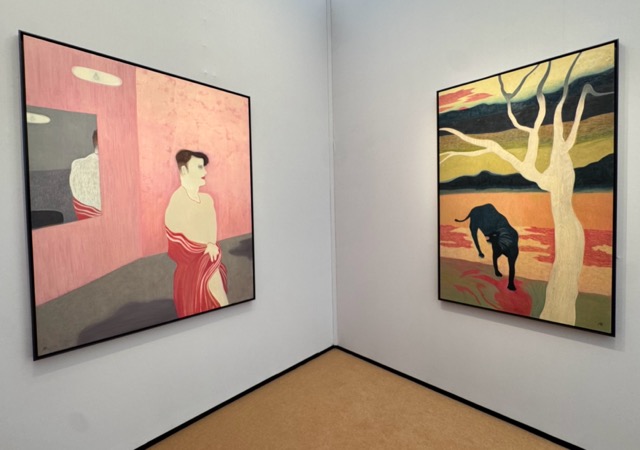
Meanwhile, Frieze Masters never disappoints in calibre or scope, and this year’s ‘Studio’ selection curated by Sheena Wagstaff with Margrethe Troensegaard is unforgettable – in particular, a masterful suite of paintings by Anne Rothenstein at the Stephen Friedman Gallery. Working in harmonious veils of oil on wood, the artist allows the panel’s grain to remain subtly visible – as if the paintings were breathing. Magical and timeless, like amber, Rothenstein’s paintings were an elegant counterpoint to the bare-soled feet emerging from a chunk of rusty marble on the stand opposite, by Irish artist Dorothy Cross, at the Frith Street Gallery.
Now in its third year, and having represented 21 artists, Studio also featured Glenn Brown’s works on paper from his charming museum collection in Marylebone, anchoring viewers in the ethos of collecting. “Placing contemporary artworks in the historically charged space of Frieze Masters provides the Studio projects with an enriched field of reference, building on the artists’ syncretic approaches to art making, which are already informed by deep excavation of older, global histories of art.” – Sheena Waggstaff.
Visit Here
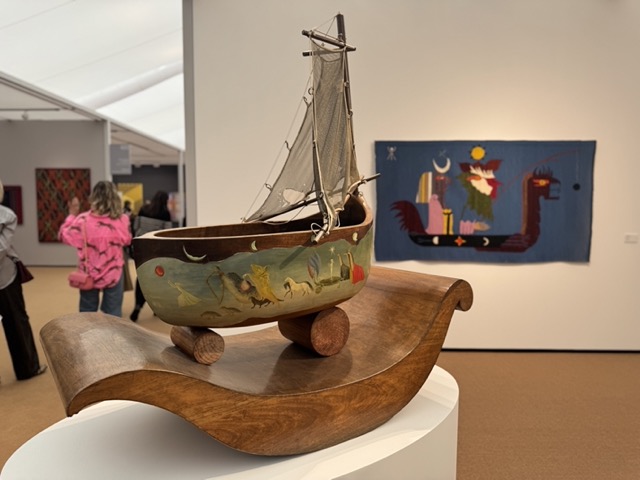
Seeing a real hand-painted, carved wooden sculpture—a cot in the shape of a ship—by Leonora Carrington @gallerywendinorris gave me much pause for thought about the many new bronze editions that have recently been flooding the market. Impossible to put my hands on it, but there was something unmistakably authentic about this piece, time-worn even. I could sense – knew intuitively – that I was seeing something made in the time of the artist, by the artist. This intangible, yet palpable quality was also manifest in a stunning, earthy work by Makinti Napanangka Am at Dlan Contemporary – as with all works of art, provenance is key in Indigenous Contemporary art, lest we fall into a post-colonial quagmire. After a pause for lunch with the legend @nancy_cadogan_studio (who is part of the Ladies who Lead dinner series at the Pem), we dropped into @shaperorarebooks – always a favourite stand. On our way, a stunning pairing of two greats @pianonobilegallery caught our eye – a small, perfectly formed Frank Auerbach painting above a Henry Moore bronze. Domestic bliss.
P.S. I Loved getting a copy @thetoerag for my trip home
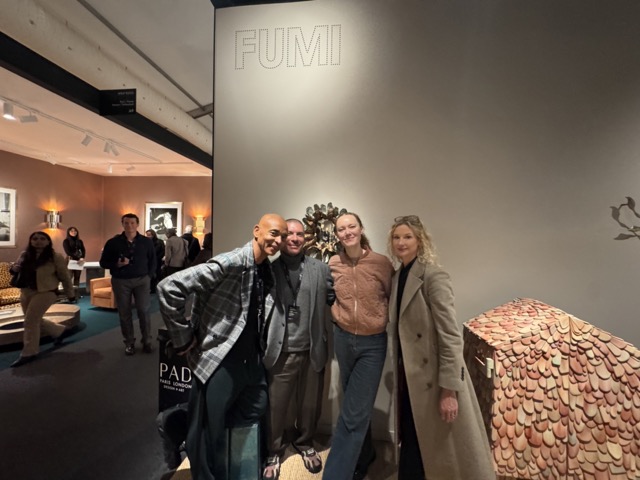
This year PAD @padesignart really was on par with Frieze Masters in both curation and content. Our VIP walk-through was with one of Gallery Fumi’s (@gallery_fumi) preeminent artists, Emma Witter, bewitching us with new wall sculptures that reflect the light in mirrored pools. Framed by electroformed copper and pearlescent painted oyster shells, like many of the works on Fumi’s booth, these pieces bridge the realms of science and art. On the floor in front of this was a wooden orb, shimmering in rainbow hues across the grain like a butterfly’s wings, by Jesse Schlesinger, ‘ Metamorphic’ 02. In a world cascading with digital transformations, to see physical objects so transformed by the human hand and heart feels increasingly precious. This was manifest in abundance at Tristan Hoare, who succeeded in installing an exquisite row of single-fired, unglazed iris by @kceramics hovering in the shadow of a single butterfly. If you have not yet seen her work or been to the gallery in Fitzrovia, treat yourself.
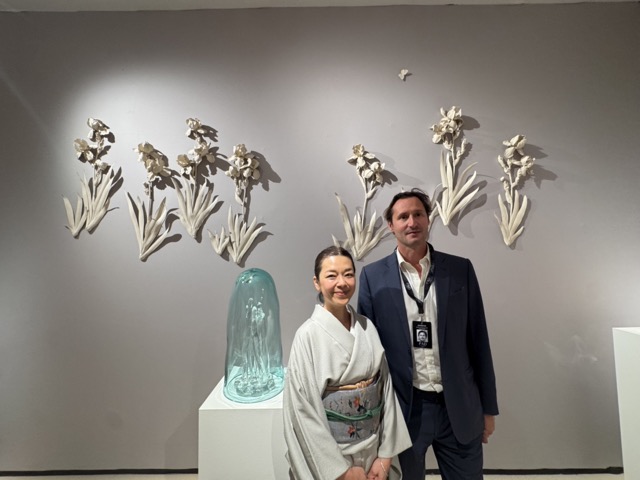
Looming out of the darkness around the corner, at Sarah Myerscough @sarahmyerscoughgallery was a row of ancient-looking, possibly time-worn bronze vessels. They were, in fact, five sculptures, recently carved from the trunk of a single fallen oak, with waxed cotton stitching by Barnaby Ash and Dru Plumb of @ashandplumb—treasures – made now but forever. As I was leaving, one actual treasure caught my eye in Second Petal Gallery: a trilogy ring in the most delicate rose tones by Nadia Morgenthaler. A pale pink central cabochon Spinel, sided by two brilliant spinels, framed by a brilliant line of diamonds set in blackened silver and underscored by a line of brown Sapphires – as perfect as a gold glass of Ruinart which we found at https://www.frieze.com/fair-facility/bar/ruinart-art-bar. (nadia-morgenthaler.com)
PART 3 – COLLATERAL HIGHLIGHTS
A few show highlights – with apologies to those I missed.
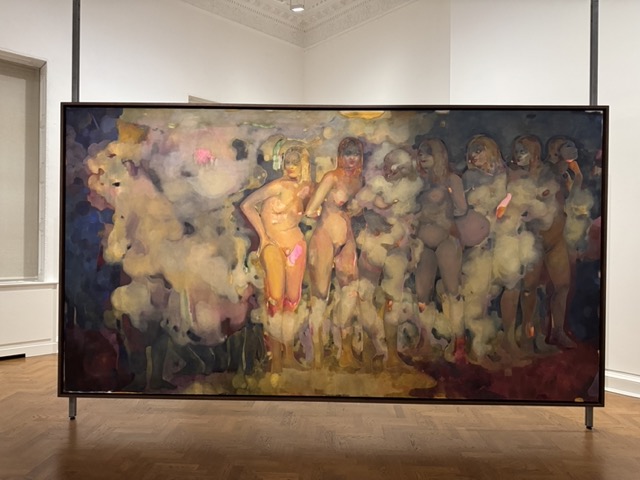
When was the last time you walked through London’s many excellent galleries that offer museum-level shows from a global community of artists – for FREE? Moreover, these remain open for the whole month, if not longer – go, skip, run to as many as you can see! Perhaps start with Danish-born, Paris-based artist Eva Helene Pade at what is arguably London’s most beautiful commercial gallery, Thaddaeus Ropac @thaddaeusropac. At only 27, this Danish-born, Paris-based artist has already had her institutional debut with ARKEN Museum of Contemporary Art in Denmark. This exhibition, titled Søgelys, is a showcase to her magnificent paintings of female embodiment writ large and suspended from floor to ceiling metal posts. Drawing upon a lineage of Northern European figurative artists, her nudes start as ‘coordinates’ on the canvas and emerge from layer upon layer of paint into clusters and crowds, or are singled out from these configurations in meditative depictions of individuals. ‘That’s what I envy so much about abstraction, it’s already working in a realm for which language does not exist.’ https://ropac.net/exhibitions/764-eva-helene-pade-sgelys/
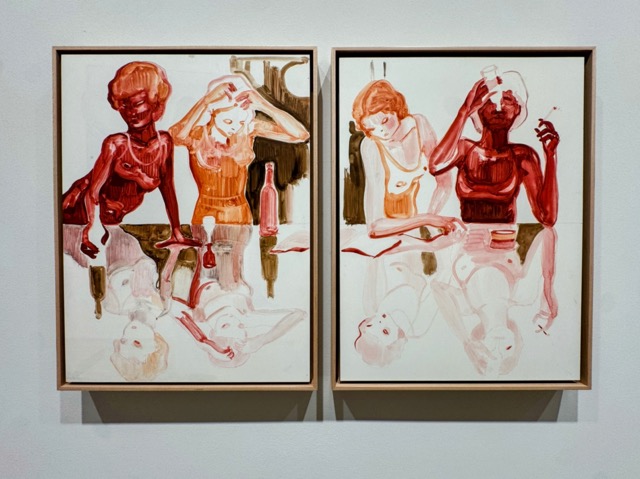
Then get over to the new – yes NEW – Sadie Coles HQ @sadiecoleshq where the one and only Lisa Brice, known for her sparse but devastating depictions of feminine intimacy in monochromatic hues, presents a knockout body of work that redresses a history of gazing from the horizon of a bar. Earthy in tones and rich in symbolism, this new suite of paintings represents an important chapter for the artist, one that explores both the light and the darkness we simultaneously inhabit. Around the corner, photographic works by @cigharvey were presented in dialogue with old masters curated by @brandei_estes – I just wish they had asked her to curate the photography section in the new women’s art fair Echo Soho, conceived by @sohoreview. En route, we were flashed by the @petticoatgallery, who lifted her skirts to reveal tiny, jewel-like works on paper, carefully sewn into pockets and available for purchase on the spot. Opportunistic in nature, but serious in presentation, the guys from U-Haul – who had pulled up outside the Arts Club in Mayfair – nearly lost their minds on discovering this mobile muse. I’m not saying anything about the number 13, but I fully expect to see more of this at our next gathering.
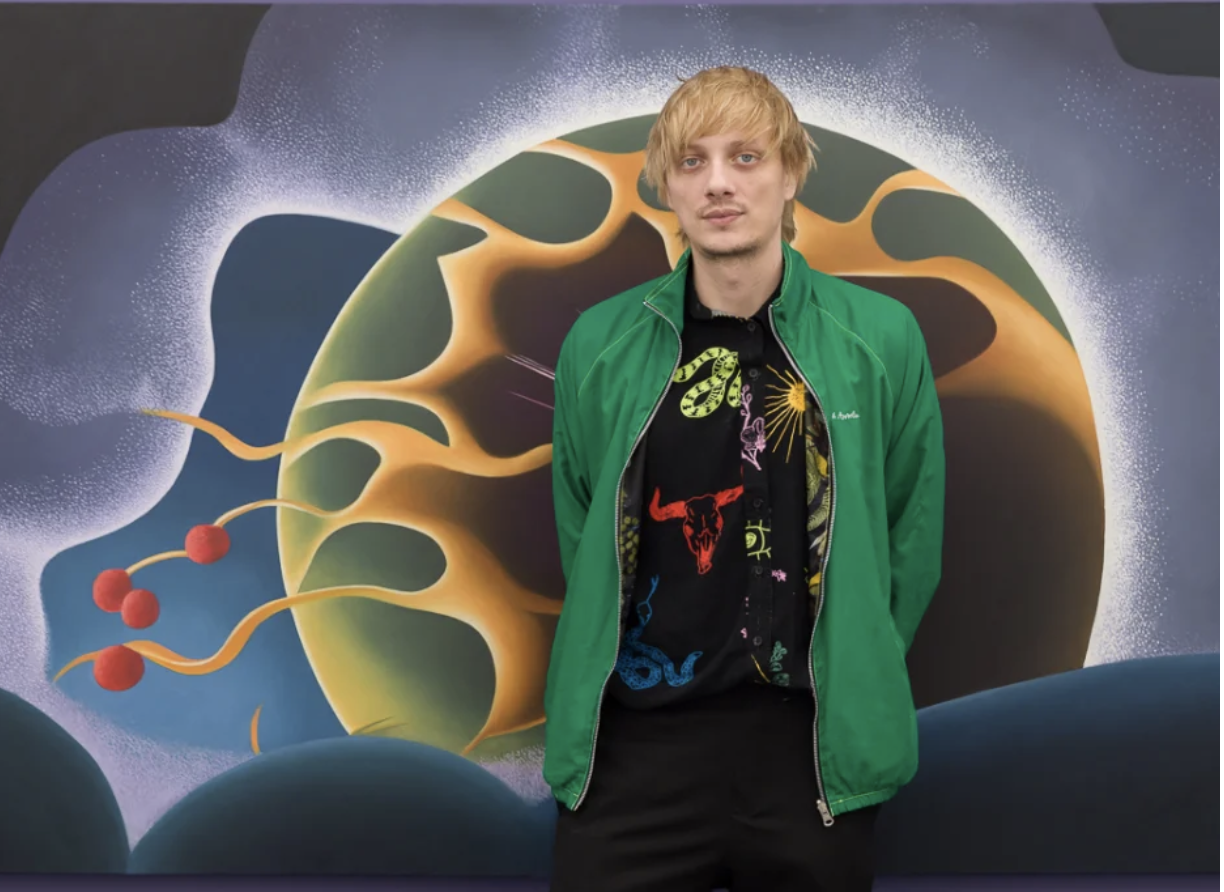
This set us up nicely for an encounter with the artist Luisen Zela-Koort at Brooke Bennington @brookebenington (also showing in the collateral fair Minor Attractions), working in response to a sequence of discoveries about the strange conditions of the subatomic world, and the unseen “Natural Factories” that proliferate in our weird world. Curated by Silvana Lagos, this show gives visceral form to what is difficult to grasp or what Zela-Koort calls “a latent desire of matter to transform itself”. Sometimes, you just need to follow an artist with a notebook and pen, so deep is their research and profound their insights – all that listening, feeling and observing whilst turning something over and over in their mind during form creation – that I feel we only scratched the surface. In her curatorial essay, Lagos says: ‘Production is often cast in the shadow of industry — tied to function, to value, and to the rhythm of progress.’ Indeed, all great research leads to more enquiry. To me, these sculptures – in particular ‘Fluctuations’ (I-III) bullseye blown glass in pale sunrise tones inside 3D printed steel cages – represent a form of revelation that we are both creators and created, tumbling around in the beautiful chaos – occasionally bumping into a star.
Nico Kos Earle
October 2025

